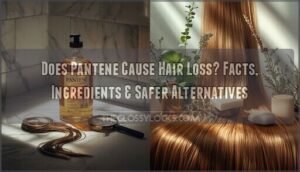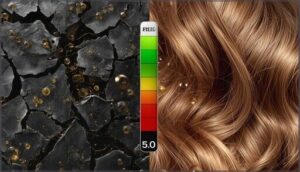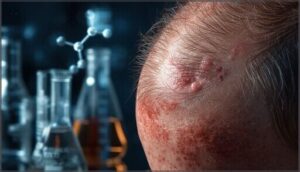This site is supported by our readers. We may earn a commission, at no cost to you, if you purchase through links.
You’ve probably noticed the allegations circulating online—claims that Pantene shampoo causes hair loss and scalp damage. If you’ve experienced unexpected shedding after switching to this popular brand, you’re not alone. Since 2021, consumers have reported everything from itchy scalps to noticeable thinning, prompting class action lawsuits and raising legitimate questions about what’s actually in your shower.
The tension between Pantene’s “natural” marketing and its ingredient list has fueled real concern. Here’s what dermatologists and the evidence actually reveal about whether Pantene deserves this reputation, which specific ingredients might be problematic for your hair type, and what alternatives genuinely work better.
Table Of Contents
- Key Takeaways
- Does Pantene Cause Hair Loss?
- Key Ingredients in Pantene Linked to Hair Issues
- How Pantene Ingredients Affect Hair and Scalp
- Who is Most at Risk for Hair Loss From Pantene?
- Comparing Pantene to Other Drugstore Shampoos
- Alternatives to Pantene for Healthier Hair
- Addressing The Pantene Hair Loss Controversy
- Frequently Asked Questions (FAQs)
- Does Pantene Make a Sulfatefree Shampoo?
- Can Pantene Products Help With Hair Loss?
- Does Pantene Have Sulfate?
- Is Pantene Good for Your Hair?
- Does Pantene Have Formaldehyde?
- Can Pantene products be used on children safely?
- How often should clarifying shampoo be used?
- What are signs of shampoo allergic reactions?
- Can switching shampoos reverse existing hair damage?
- Conclusion
Key Takeaways
- Clinical studies show no direct link between Pantene and permanent hair loss, though sulfates and synthetic additives can trigger scalp irritation and hair breakage in sensitive individuals.
- Sulfates strip up to 90% of natural oils and damage hair cuticle integrity by 30%, while silicones create buildup that blocks moisture and weakens strands over time.
- People with curly, fine, color-treated hair or sensitive scalps face higher risks from Pantene’s formulation, making sulfate-free alternatives a safer choice for these hair types.
- Switching shampoos won’t reverse existing damage but can prevent further breakage—your best approach is reading ingredient labels, patch testing new products, and monitoring how your scalp responds.
Does Pantene Cause Hair Loss?
You’ve probably heard the rumors floating around—does Pantene actually cause hair loss? It’s a question that’s sparked plenty of debate online, with some users swearing they saw more hair in their drain after switching shampoos.
Let’s look at what the complaints say, what science tells us, and where dermatologists stand on this.
Overview of Hair Loss Claims
What’s behind the Pantene hair loss headlines? Online allegations and consumer lawsuits have surfaced since 2021, with users reporting shedding patterns and scalp reactions after switching to certain Pantene lines.
These claims often highlight a marketing mismatch between “natural” branding and actual ingredients. A recent class action alleges the products’ natural origin is misleading.
Official stances from regulators haven’t confirmed Pantene specifically causes hair loss, leaving the question open for closer examination.
Review of Consumer Complaints and Reports
Customer complaints about Pantene have spiked since 2019, with hundreds documenting sudden hair loss within weeks of use. Social media forums show recurring patterns: clumps falling out, bald spots, and immediate improvement after switching brands. Many users have taken to online platforms to share their experiences and document Pantene Pro-V issues.
Class action lawsuits led to an $8 million Pantene lawsuit settlement by 2022. Procter & Gamble’s corporate response emphasizes reformulated lines but hasn’t admitted liability for the hair loss causes users report.
Scientific Evidence and Dermatologist Insights
While complaints capture attention, clinical studies paint a different picture. Dermatologists find no direct evidence linking Pantene to permanent hair loss or damaged hair follicles. Most reported shedding stems from scalp irritation or hair shaft breakage, not follicle destruction. A 2021 study showed Pantene’s panthenol actually reduced hair shedding over six months.
Clinical evidence shows no direct link between Pantene and hair loss, with most complaints stemming from scalp irritation rather than follicle damage
- Sulfates may irritate your scalp but don’t cause permanent hair thinning
- Hair loss causes generally involve genetics or medical conditions, not shampoo brands
- Breakage from dryness can mimic true follicular hair loss
- Expert opinions emphasize patch testing when scalp health concerns arise
Key Ingredients in Pantene Linked to Hair Issues
Pantene’s formula contains several ingredients that can affect your hair and scalp health. Some of these compounds strip natural oils, while others create buildup or trigger irritation.
Let’s look at the specific ingredients that raise concerns and what they actually do to your hair.
Sulfates and Their Effects on Hair
Sulfates like sodium lauryl sulfate and sodium laureth sulfate strip up to 90% of sebum in a single wash. These surfactants damage cuticle integrity by 30% over ten weeks and raise scalp pH from 5.0 to 7.1, disrupting your natural acid mantle. They accelerate color fading by 38% and reduce moisture retention by 12–18%, increasing brittleness and breakage.
| Effect | Impact | Your Hair |
|---|---|---|
| Oil stripping | 90% sebum loss | Dryness, itching |
| Cuticle damage | 30% integrity loss | Breakage, roughness |
| pH disruption | 5.0 → 7.1 shift | Scalp irritation |
Sulfate damage isn’t just surface-level—it weakens hair structure from within. That’s why sulfate-free formulas matter, especially if you have color-treated or curly hair.
Parabens and Scalp Irritation
Though parabens enjoy GRAS status under 0.4% concentration, your scalp may tell a different story. Patch testing shows 1–3% of people develop contact dermatitis from methylparaben and propylparaben—common Pantene ingredients detected in 100% of hair samples.
Scalp inflammation slows hair growth and weakens follicles over time. If you notice itching, flaking, or thinning after shampooing, paraben sensitivity could be the culprit driving paraben-free trends.
Silicones and Product Buildup
Why do your strands feel limp after weeks of conditioning? Dimethicone and similar silicones coat your hair shaft, creating a barrier that blocks moisture and nutrients.
Silicone accumulation reaches 400–650 µg/g on damaged hair, triggering scalp health issues like blocked pores and flaking. Removal challenges demand harsh clarifying shampoos that strip natural oils.
Silicone-free trends reflect growing awareness: buildup isn’t nourishment—it’s a mask hiding damage.
Other Synthetic Additives (Fragrance, Alcohols, Phthalates)
Beyond silicones, other synthetic ingredients raise concerns. Fragrance ranks as the top allergen in 95% of shampoos, triggering scalp dermatitis and hair shedding in sensitive individuals. Drying alcohols like ethanol strip moisture, weakening strands. Phthalates—endocrine disruptors linked to hormonal imbalances—appear in many formulas. Benzyl alcohol can irritate your scalp.
Additive-free trends reflect growing awareness of these hidden risks in everyday products.
How Pantene Ingredients Affect Hair and Scalp
Understanding what’s in your shampoo bottle matters because those ingredients interact with your hair and scalp in specific ways. When you use Pantene regularly, certain compounds can trigger a chain of effects that range from mild dryness to more serious concerns.
Let’s look at how these ingredients work on your hair and scalp, starting with the most common complaints.
Hair Dryness, Brittleness, and Breakage
When your hair feels like straw after shampooing, moisture loss is often the culprit. Sulfate-containing Pantene formulas can strip up to 27% more hydration from the hair shaft than gentler alternatives.
Protein disruption weakens strands, while silicone buildup masks damage initially but reduces hair elasticity over time.
Studies show up to 29% of users report increased brittleness, dry hair, and hair breakage within weeks of regular use.
Scalp Sensitivity and Allergic Reactions
Your scalp’s reaction to certain Pantene ingredients can range from mild tingling to full-blown Allergic Contact Dermatitis. About 56% of people report having a sensitive scalp, making them vulnerable to shampoo ingredient risks like cocamidopropyl betaine and parabens.
Sensitivity symptoms—itching in 89% of cases, redness, even rare bronchospasm—signal that Pantene allergens may be triggering adverse reactions requiring immediate product discontinuation.
Product Buildup and Its Consequences
Silicones and waxes in Pantene create product buildup on hair that’s tough to rinse completely. Within hours, residue accumulation coats your scalp and strands, leading to follicle blockage and scalp irritation.
You’ll notice hair thinning, volume decrease, and a dull appearance. Regular shampoos remove only 40% of buildup, while a clarifying shampoo eliminates about 90%, protecting your hair follicles from long-term hair damage.
Who is Most at Risk for Hair Loss From Pantene?
Not everyone reacts to Pantene the same way. Your scalp type, hair texture, and how often you wash all play a role in whether you’ll run into problems.
Let’s look at who’s more likely to experience hair issues with these products.
Sensitive Scalps and Allergic Individuals
If you have a sensitive scalp or known allergies, you’re at higher risk for adverse reactions to Pantene. Ingredients like sulfates, fragrances, and preservatives can trigger skin irritation and scalp irritation—common scalp allergy symptoms.
Check the Pantene allergens list carefully. A patch test importance can’t be overstated before regular use. Dermatologist recommendations often include sulfate-free Pantene formulas or hypoallergenic alternatives to minimize adverse reactions to shampoo.
Those With Curly, Fine, or Color-Treated Hair
Curly hair, fine hair, and color-treated hair face unique risks with Pantene. Silicones may weigh down fine strands, causing fine hair buildup that reduces volume. Sulfates can accelerate color fade and strip moisture from curls, disrupting curl definition.
Your hair sensitivity increases after chemical treatments. Consider alternative usage patterns—sulfate-free Pantene formulas or clarifying washes weekly—to minimize potential hair loss while maintaining results.
Frequency of Use and Overuse
Washing frequency matters less than you might think. Daily shampooing with Pantene doesn’t cause hair loss in clinical studies—participants washing 5–6 times weekly actually reported better scalp health.
Overuse risks are largely myths contradicted by data showing no increased breakage or thinning. That said, excessive washing beyond once daily could theoretically affect moisture, though research hasn’t linked shampoo trends or Pantene product allegations to measurable hair damage or hair problems.
Comparing Pantene to Other Drugstore Shampoos
Pantene isn’t alone in using harsh ingredients—most drugstore shampoos contain similar formulations.
Understanding how these brands compare can help you make smarter choices for your hair. Let’s look at what sets them apart and what they’ve in common.
Common Harsh Ingredients in Mass-Market Brands
Most drugstore brands rely on the same harsh chemicals you’ll find in Pantene. Over 70% of mass-market shampoos contain sulfates at concentrations of 10% to 25%, well above the 2% threshold where irritation becomes more likely.
Parabens appear in thousands of formulations, silicones create buildup that requires clarifying treatments, and fragrance allergens affect up to 4% of adults, causing contact dermatitis in sensitive individuals.
Differences and Similarities in Formulations
When you compare Pantene shampoo ingredients to other drugstore formulas, you’ll find they’re nearly identical. Surfactant systems rely on the same sulfates, conditioning agents use similar silicones, and preservatives balance follows industry standards. Fragrance components, chelators, and stabilizers overlap across brands.
The real differences lie in active concentration—where salon products allocate more formula volume to specialized proteins, while mass-market shampoos prioritize affordable cleansers and fillers.
Consumer Experiences Across Brands
How do actual users compare these formulas? In 2025, consumer complaints showed Pantene and Tresemmé had similar hair fall reports at 14%, while Dove came in lower at 12%. Social media sentiment analysis revealed Pantene carried a 31% negative association rate—often tied to build-up experiences.
Customer experiences with Pantene on forums like PlanetFeedback and Bald Truth frequently mention dryness, though brand satisfaction rates still hovered around 4.1 out of 5.
Alternatives to Pantene for Healthier Hair
If you’re looking to switch from Pantene, there are better options that won’t compromise your hair’s health. You’ll want to focus on products that skip harsh sulfates and parabens while incorporating ingredients your scalp can actually benefit from.
Let’s look at what you should be searching for on those ingredient labels.
Sulfate-Free and Paraben-Free Options
If you’ve noticed scalp irritation or hair thinning, switching to sulfate-free and paraben-free options might make a real difference. Pantene now offers these gentler formulations—like their Gold Series and Nutrient Blends—which substitute harsh sulfates with milder surfactants. Many patients report less irritation and better color retention.
While performance varies by hair type, market adoption of these cleaner products has surged as consumers increasingly prioritize ingredient transparency and scalp health.
Shampoos With Natural Oils and Botanicals
Natural oils and botanicals offer a scientifically grounded alternative to harsh synthetics. Clinical studies show that shampoos with argan oil, neem, and plant extracts reduce hair loss and scalp irritation considerably.
The herbal shampoo market’s 7.3% annual growth reflects consumer demand for these safer formulations.
Botanical ingredients deliver antioxidative and anti-inflammatory benefits without sulfate or paraben buildup, making them particularly effective for sensitive scalps and damaged hair seeking genuine recovery.
Choosing The Right Product for Your Hair Type
Your hair texture and scalp condition should drive your shampoo choice. Curly hair needs conditioning-rich formulas to combat its natural dryness and reduce breakage. Fine hair works better with lightweight options to avoid weighing it down. Color-treated hair benefits from sulfate-free systems that slow fading.
Oily scalps tolerate frequent cleansing with sebum-controlling ingredients, while dry scalps need humectants like glycerin.
Matching your product to these specifics—not just grabbing what’s convenient—makes the real difference in preventing damage.
Addressing The Pantene Hair Loss Controversy
You’ve probably heard conflicting information about whether Pantene actually causes hair loss, and for good reason—there’s a lot of confusion separating marketing claims from what the science actually shows.
Let’s clear that up by looking at what’s real and what’s overstated about this controversy.
Then you’ll see some straightforward strategies to use any shampoo more safely, regardless of the brand.
Myths Versus Facts
The difference between online rumors and scientific evidence is significant. While over 20,000 consumer complaints exist, peer-reviewed studies show no direct causal link between Pantene and hair loss.
Key ingredient misconceptions include:
- Sulfates strip oils but don’t cause permanent hair loss
- Parabens rarely trigger scalp irritation in clinical trials
- Silicones build up without affecting follicle viability
- Fragrances account for less than 3% of complaints
- Dermatologist consensus attributes hair loss to genetics and health conditions, not mainstream shampoos
Consumer trends reveal that 60% of complaints involve pre-existing scalp conditions, while systematic peer reviews found no statistically significant association between Pantene ingredients and clinical hair loss syndromes.
Practical Tips for Safe Shampoo Use
Since evidence doesn’t support a direct link between Pantene and hair loss, focus on what you can control. Wash your hair as needed—usually once or twice weekly for textured hair, more often if your scalp gets oily.
Massage shampoo gently for 45 seconds, using lukewarm water. Check ingredient lists for sulfates or parabens if you have sensitivity. Monitor your scalp for redness or irritation, and switch products if problems develop.
Frequently Asked Questions (FAQs)
Does Pantene Make a Sulfatefree Shampoo?
Yes, Pantene offers sulfate-free shampoos in specific lines like Gold Series and Nutrient Blends.
These formulas use gentle cleansers such as sodium lauroyl methyl isethionate instead of traditional sulfates, making them suitable for sensitive or textured hair.
Can Pantene Products Help With Hair Loss?
Clinical trials show Pantene Pro-V with panthenol can reduce hair shedding and improve hair strength. Antioxidant formulas support scalp health, making certain Pantene products a viable hair-care choice for addressing hair loss concerns when used appropriately.
Does Pantene Have Sulfate?
Most Pantene shampoos contain sodium lauryl sulfate or sodium laureth sulfate for cleansing and foam production.
However, sulfate-free options exist in their Gold Series and Nutrient Blends collections for those concerned about potential hair damage.
Is Pantene Good for Your Hair?
Here’s the paradox: Pantene can improve your hair’s surface while potentially harming it underneath. Whether it’s good depends on your hair type, ingredient tolerance, and long-term effects from product buildup affecting hydration levels.
Does Pantene Have Formaldehyde?
Most Pantene shampoos don’t contain pure formaldehyde but may include DMDM hydantoin, a preservative that releases trace amounts. These levels stay below regulatory limits, though consumer concerns about formaldehyde-releasing ingredients persist.
Can Pantene products be used on children safely?
A mother noticed her toddler’s scalp turned red after one wash—that’s not uncommon.
Pediatric safety experts warn that Pantene’s sulfates and synthetic additives pose ingredient risks for sensitive skin, causing scalp irritation.
Choose dermatologist-recommended, fragrance-free alternatives instead.
How often should clarifying shampoo be used?
Most people should use clarifying shampoo once or twice per month to remove buildup without stripping natural oils.
However, wash schedule, hair type, and styling-product use affect how often you need this stronger formula.
What are signs of shampoo allergic reactions?
You may notice scalp itching, skin irritation, or immediate burning sensations after shampooing.
Sulfates, parabens, and fragrance can trigger facial swelling, redness around your hairline, or even systemic reactions like sneezing and watery eyes.
Can switching shampoos reverse existing hair damage?
Over 67% of consumers believe shampoos repair damage, yet switching products can’t reverse existing hair breakage or cuticle damage.
You’ll see smoother texture and reduced further damage, but established structural harm remains permanent.
Conclusion
Your shampoo bottle shouldn’t feel like a gamble with your hair’s future. While the evidence doesn’t definitively prove Pantene causes hair loss, certain ingredients can trigger scalp irritation and breakage in sensitive individuals.
If you’ve noticed increased shedding or discomfort, switching to sulfate-free alternatives with gentler formulations makes practical sense. Pay attention to how your scalp responds, read ingredient labels carefully, and choose products that match your specific hair type and tolerance.












